The better to insulate the attic: the best thermal insulation materials for arranging the attic roof
Attic is a well-maintained attic, which is often used as a living room or an additional technical room. It differs in that it requires enhanced thermal insulation, as it has a large contact area with a cold atmospheric environment.
Depending on the purpose of using the attic, heaters are selected that differ in the degree of thermal conductivity, density, and combustibility. We will figure out the better to insulate the attic so that it turns from a cold attic into a room suitable for housing or storage.
The content of the article:
Warm attic - additional residential meters
No matter how large the room is, there is always a need for another room - a guest bedroom, a games room, a gym or just a convenient storage room.
According to normative documentation, the attic is a room formed by a facade and roofing. According to sanitary standards, the distance from the floor to the line of intersection of the wall with the roof should be at least 1.5 m, and to the ceiling - 2.5 m. At the same time, a section with a “high” ceiling (2.5 m or more) should occupy from 50 % of the total area of the attic.
It is obvious that in private housing construction there are deviations from the standards. For example, factors such as the shape and size of the roof can influence the configuration of the attic: in houses with high roofs, attic ceilings are higher, but the floor area is narrower.
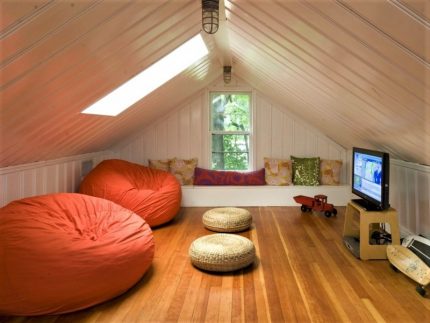
To increase the size of the attic, resort to various techniques: increase the height of the lower tier of the sloping roof, make the facade walls higher. Interesting attic design options can be found on the Roofing Guide website.
However, with all the advantages of an additional comfortable room, there are nuances that increase the cost of construction and finishing works:
- installation of windows;
- ventilation equipment;
- hydro and thermal insulation.
The last point is also important because literally everything will have to be insulated: floor, pediments, walls, often consisting of two parts - the facade and roofing. At the same time, the same requirements are imposed on heat-insulating materials as for insulation for residential premises. In addition to suitable technical characteristics, they must be absolutely safe.

Overview of thermal insulation materials for roofs
Today, you can find everything on the market: from long-established glass wool to natural and foil materials, which are less often used in practice. Consider the better to insulate the walls and the floor of the attic from the inside, so that the attic becomes warm, and in the near future did not have to make repairs.
Option # 1 - glass wool
Glass wool has gained popularity due to its low cost, so if you want to save on thermal insulation, you can use rolled mats or more convenient for mounting plates. Raw materials for production are specially purified quartz sand and waste from the glass industry.
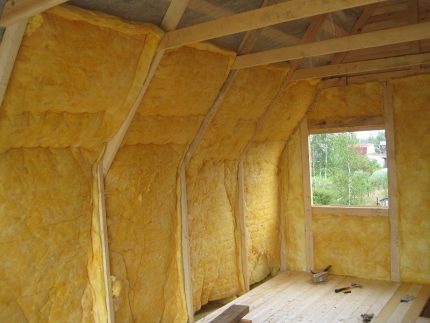
In addition to affordable cost and light weight, the material has the following advantages:
- elasticity, which allows laying slabs or mats with a snug fit to each other and rafters;
- flexibility useful for warming complex sections of the roof;
- unattractiveness for rodents, which is explained by the lack of natural materials in the composition.
However, there are also enough shortcomings. For example, they include high hygroscopicity, requiring the use of vapor barrier on the inside and ventilation to evaporate moisture - on the outside.
Due to brittleness, fiberglass is destroyed, and the smallest specks of dust spread in the air, creating a dangerous environment for health. In addition, dubious companies use formaldehyde as a binder in production, so it is better to use a more expensive but safe material.
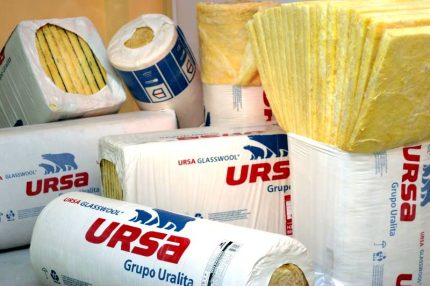
For example, the Pitched Roof of the Izover Geo line is not only safe for residents, but also refers to non-combustible materials.
Option # 2 - mineral wool
Unlike glass wool, mineral wool is produced from a melt of igneous rocks, which during processing form a less brittle, more durable and elastic material. Accordingly, the operational properties of this insulation are higher.
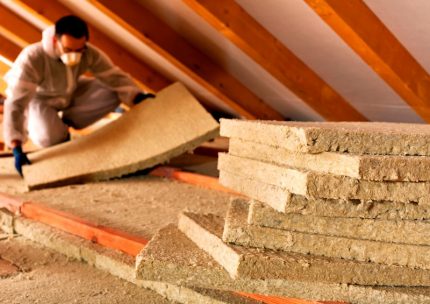
Hygroscopicity is lower than that of glass wool, but moisture absorption still occurs, so you should not refuse from vapor barrier during installation. Vapor permeability is within normal limits, and if proper conditions are created for evaporation of moisture from the surface, the material will last a long time.
Brand products do not contain harmful substances, which is guaranteed by a sanitary certificate. If you doubt the safety of thermal insulation, ask for documentation upon purchase.
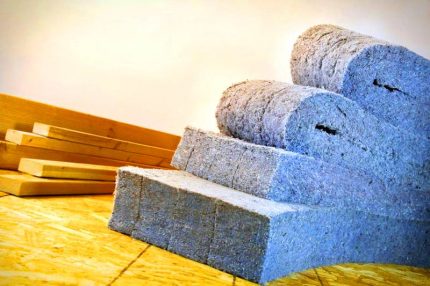
Modern basalt heaters are convenient to install, which is also accompanied by some developments of manufacturers. For example, ROCKWOOL boards have a spring-loaded edge zone that provides a snug fit, reliability and stability.
The main disadvantage of promoted brands, popular among builders - TechnoNIKOL, PAROC, Izovol, ROCKWOOL - is considered the cost.
Option # 3 - Ecowool
A real discovery was the material produced on an organic basis - ecowool. Cellulose fibers, which are obtained in the processing of wood, cardboard, recyclable materials, demonstrate excellent thermal insulation properties.
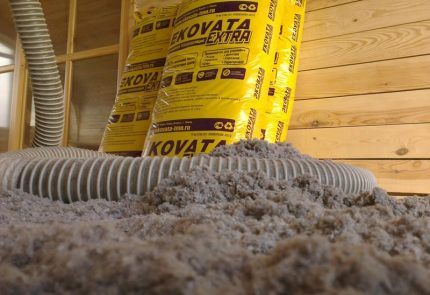
According to many technical characteristics, ecowool “steps on the heels” of mineral analogues:
- thermal conductivity - 0.038-0.043 W / m × ° C;
- flammability degree - G2 (self-extinguishing, slightly combustible);
- layer density - 45-75 kg / m³.
The name "ecowool" speaks for itself - the material is considered environmentally friendly, does not contain hazardous toxic substances. However, due to antiseptic treatment, it does not attract rats and is protected from decay.
The disadvantage of ecowool is a high degree of hygroscopicity, therefore, in addition to the rolled or sprayed material, the installation estimates should include hydro- and vapor-insulating polyethylene films or polymer membranes.
There are two ways to install ecowool when attic attic is insulated: “dry” and “wet”.
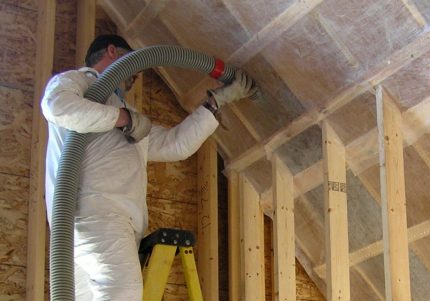
For the “wet” method of applying ecowool on the roof elements from the inside, an adhesive solution is used that ensures maximum adhesion of the material to the base and increases the strength of the heat-insulating layer.
The main disadvantage of the insulation is the availability of special equipment for styling. Installers must have special skills, without initial experience it is better to choose materials that are easier to install - for example, mineral wool in slabs.
Option # 4 - Styrofoam
Inexpensive, but dubious material for warming attic rooms. Let's try to figure out why the foam still popular today is undesirable and even dangerous to use in the process of thermal insulation.

However, material shortcomings become weighty arguments against its use.
By cons include the following points:
- often the foam does not meet the declared characteristics, as it is produced everywhere without taking into account any technical requirements;
- it is a combustible material that releases toxic substances during a fire - as you know, people die in the very first minutes after a fire not from fire, but precisely because of poisoning by combustion products;
- the foam quickly collapses - it breaks up into individual granules, as a result of which its heat-insulating qualities are lost.
Manufacturers who are serious about the quality of their products take measures to improve them. However, slabs of even well-known brands are inferior in characteristics to other materials. By the way, in Europe, polystyrene is prohibited for use in the residential sector, while our compatriots continue to save and put their families at risk.
Option # 5 - extruded polystyrene foam
Another thing is plates made of extruded polystyrene foam, which is distinguished by both production technology and operational qualities.
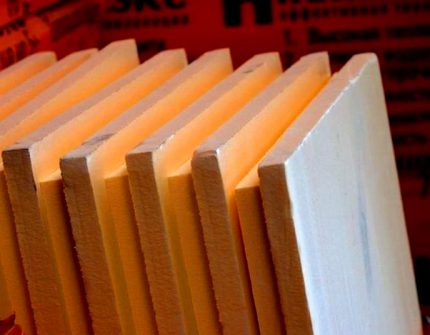
EP is more expensive than polystyrene, however, the advantages of the material make you close your eyes to the difference in price and prefer it.
The advantages of extruded polystyrene include:
- thermal conductivity coefficient - on average 0.030 ± 0.032 W / m × ° С;
- very low degree of hygroscopicity;
- sustained geometry of plates, not changing with time;
- strength due to protection against ingress of water;
- combustibility class - G2, characterized by self-extinguishing.
Unfortunately, in case of fire, expanded polystyrene also emits toxic substances, albeit not to the same extent as polystyrene, but you should not forget about it.
Thanks to the sophisticated production technology, there are almost no counterfeits on the market - only serious enterprises can afford to produce insulation.
The disadvantages include rigidity and lack of elasticity. Unlike elastic mineral wool, EP boards are difficult to adjust to specific sizes so that after installation there are no gaps between them. Typically, the gaps between them are blown with foam or other sealant.
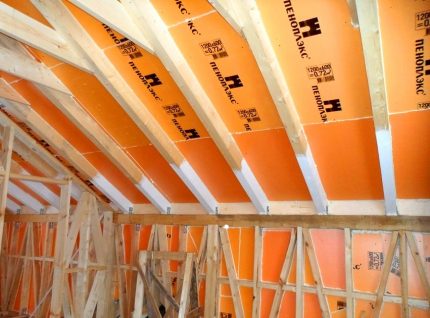
This method is often used when they want to create an interior in the loft style: beams openly located under a layer of insulation and inner lining look more than picturesque.
Among the manufacturers of extruded polystyrene foam there are leaders. For example, Penoplex brand products are widely known, the name of which has already become a household name. Quality boards are distinguished by the fact that they do not require the use of waterproofing and are quite suitable for creating a continuous roofing lathing.
The rules for working with extruded polystyrene foam are described in this stuff.
Option # 6 - sprayed polyurethane foam
Spraying foam thermal insulation from the inside of the roof is an excellent opportunity to create a seamless durable insulation without cold bridges and joints requiring filling. One of the most high-quality “sprayers” is polyurethane foam, which creates an effective thermal insulation layer.
Advantages of sprayed insulation:
- thermal conductivity coefficient - 0.03 W / m × ° С and less;
- optional use of vapor barrier;
- good adhesion to various surfaces;
- lack of prior training;
- minimum load on the rafter structures.
The thin but dense layer created by the cured PUF is also an excellent soundproofing protection, which is important for the attic used as a bedroom.
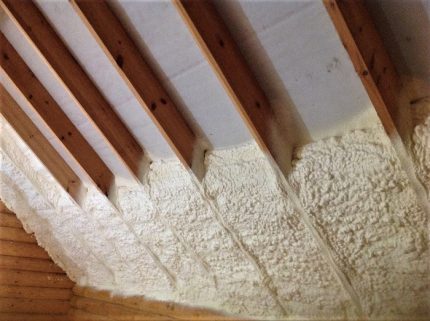
Insulating polymer foams, among other advantages, have an anti-corrosion effect: the PPU-treated metal parts do not rust, receiving additional protection. Polyurethane foam also does not allow moisture, therefore it is considered an excellent waterproofing material.
The disadvantages include high cost, the need for spray equipment. It is not possible to independently carry out thermal insulation without special education, therefore, another expense item is the services of a team of trained installers.
Option # 7 - PIR plates
Not so long ago, a material appeared on the market that combines the positive qualities of popular heaters: the thermal conductivity of polyurethane foam, the strength and hydrophobicity of extruded polystyrene foam, and the fire resistance of mineral wool. These are PIR plates - products made of polyisocyanurate foam having a rigid structure with small cells filled with gas.
The main achievement of manufacturers of PIR-plates is considered to be the coefficient of thermal conductivity, reaching 0.022 W / m × ° C.

In addition to conventional plates, foil products are also produced, additionally protected from moisture by a thin metallized layer. The plates are interconnected by tongue-and-groove locks, due to which volumetric seamless areas can be created on smooth surfaces.
Leaders among enterprises producing heaters have already taken new developments into service and are producing PIR plates under their own brands. For example, products from the Technonikol company become popular, and the manufacturer specializes in the manufacture of insulation for all types of building structures.

The wide distribution of products superior to analogues in technical characteristics is hindered only by high cost. 13-15 thousand rubles for one cubic meter of material - it is really expensive compared to mineral wool or polystyrene foam.
In addition to the listed best types of thermal insulation for the attic, mats made of natural wool, expanded clay and even wood fiber boards are also used, however, these materials are not so common due to inappropriate characteristics for some reason or have complicated installation technology.
Attic floor insulation methods
No matter how warm the walls in the attic are, it is also necessary to insulate the floor, especially if the room will be used as a bedroom or a playroom. Do not forget that this is also the insulation of the ceiling of a one-story house or the upper floor in a 2-3-story building.
When insulating the attic floor, two conditions must be remembered:
- the material should be light, not create a load on the ceiling;
- thermal insulation characteristics must be at a high level.
Given these requirements, you can use glass wool, ecowool, mineral wool, extruded polystyrene foam, PIR-plates. The insulation is placed under the finish covering, for which the processed boards are usually chosen.
Advantages of insulation:
It is difficult to give exact advice on what material is better to decorate and insulate the attic, since a lot depends on the climate in the region, the size of the attic, the features of the roofing and the roof structure itself. Not the last place is occupied by the financial opportunities of the homeowner.
We also recommend that you read the step-by-step instruction on warming the attic with your own hands. More details - go to the link.
Conclusions and useful video on the topic
An example of attic insulation with mineral wool:
Thermowave technology:
The universal material is stone wool. Full review from the manufacturer TechnoNIKOL:
When choosing a heater, do not forget that the attic is a living room, which should not only be warm, but also safe. If possible, purchase materials that comply with sanitary standards, with the appropriate class of flammability and the absence of toxins in the composition.
And the best characteristics of thermal conductivity, stability and hygroscopicity are a guarantee of comfortable use of the room for a long time.
Which of the attic insulation did you prefer and why? Are you satisfied with the result? Please share your opinion with visitors to our site. Leave your comments in the box below.

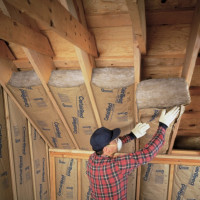 Attic roof insulation: a detailed instruction on the installation of thermal insulation in the attic of a low-rise building
Attic roof insulation: a detailed instruction on the installation of thermal insulation in the attic of a low-rise building 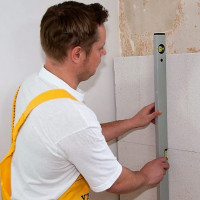 How to insulate the wall in the apartment from the inside: the best technology + workflow
How to insulate the wall in the apartment from the inside: the best technology + workflow  How to insulate a cold apartment from the inside: suitable materials + installation instructions
How to insulate a cold apartment from the inside: suitable materials + installation instructions 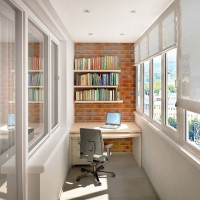 How to insulate a loggia: options + instructions for installing a do-it-yourself warming system from the inside
How to insulate a loggia: options + instructions for installing a do-it-yourself warming system from the inside 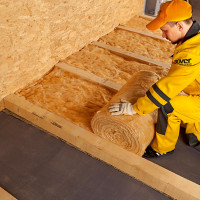 Insulation for the floor in a wooden house: materials for thermal insulation + advice on choosing insulation
Insulation for the floor in a wooden house: materials for thermal insulation + advice on choosing insulation 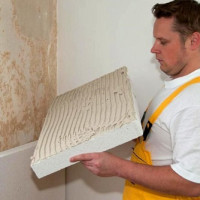 Types of insulation for the walls of the house from the inside: materials for insulation and their characteristics
Types of insulation for the walls of the house from the inside: materials for insulation and their characteristics  How much does it cost to connect gas to a private house: the price of organizing gas supply
How much does it cost to connect gas to a private house: the price of organizing gas supply  The best washing machines with dryer: model rating and customer tips
The best washing machines with dryer: model rating and customer tips  What is the color temperature of light and the nuances of choosing the temperature of the lamps to suit your needs
What is the color temperature of light and the nuances of choosing the temperature of the lamps to suit your needs  Replacement of a geyser in an apartment: replacement paperwork + basic norms and requirements
Replacement of a geyser in an apartment: replacement paperwork + basic norms and requirements
Polyfoam and all its more fashionable and modern derivatives are easy to install, but too fire hazardous. It stops me. I know that there are self-extinguishing ones, but they cost too much. So for now I'm leaning towards basalt.